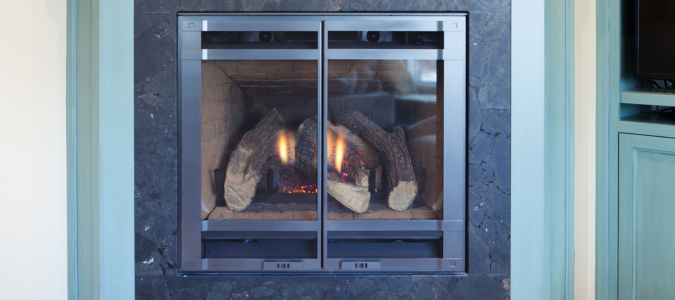
There’s nothing like having a fire in the fireplace to make a home feel cozy. Adding a fireplace to your home, or upgrading your existing fireplace can be a big decision, especially in Central Texas, where the weather rarely requires the heat a fireplace can give.
Should I Choose a Gas or Wood Fireplace?
Unlike more northern areas of the country, a fireplace in Central Texas is more aesthetic than functional. So which is better: a wood-burning fireplace or a gas fireplace? Let’s look at the pros and cons of each.
Wood Fireplaces
The wood-burning fireplace is iconic; it’s how homes have traditionally been heated, going back to the first caveman building a fire in his cave. The wood-burning fireplace hasn’t changed much in over 100 years, although newer fireplaces come with various fireboxes (the area where the wood is placed), inserts and front pieces.
Pros of Wood Fireplaces
The benefits of wood fireplaces include:
- Fuel cost. Depending on where you live, getting firewood can be as easy and cost-effective as walking into the back of your property and chopping down a few trees. Even if you buy firewood, the cost is minimal for what you would use in Central Texas.
- Experience. Nothing compares to a roaring fire on a chilly, quiet night, sipping a steamy mug of hot chocolate. You may get a similar feel with a gas stove, but you miss out on the smell, the crackle and the warmth of a traditional wood-burning fireplace. Imagine camping around a gas-powered fire on a summer evening, exchanging stories and roasting marshmallows; it’s not the same experience.
Cons of Wood Fireplaces
There are some drawbacks of wood fireplaces, including:
- Fuel variability. Cutting down your trees for wood may sound simple, but there’s more to it than that. Freshly-cut wood, or “green” wood, contains too much sap to burn well, so it needs to be split and stacked to dry. Depending on the type of wood, drying can take up to six months for the wood to be usable for a fire. Buying green wood may be less expensive, but it means you won’t be able to use it right away, and even seemingly dry wood bundles can contain green pieces toward the middle of the bundle. Keeping firewood piled up outside your home for an extended period can also attract pests you don’t want near your home.
- Installation. The installation of a wood fireplace can require removal of parts of a wall in your home and the installation of an external chimney, so a major renovation may be involved.
- Maintenance. Wood fireplaces require maintenance, only some of which can be DIY. Before the fireplace can be used, it needs to be cleaned by a chimney professional. While the chimney is being cleaned, the professional will check to make sure there are no cracks, no missing pieces, no animals stuck in the flue and that everything is functioning properly. Between fires, the firebox needs to be cleaned out, the ashes removed and properly disposed of and the remaining wood stored properly to keep bugs and rot away. During clean-up, it’s important to make sure that furniture, floors and the surrounding areas are protected against staining from the soot.
- Heat. In the summer, in Texas, having the roaring fire of a traditional wood fireplace isn’t practical, especially when it’s over 100 degrees outside.
Gas Fireplaces
Gas fireplaces are a more modern invention, although the first gas fireplaces appeared in homes over 100 years ago. Gas fireplace technology continues to grow and change, enabling a smaller footprint, more freestanding options, less hassle, and fewer changes in your home’s architecture.
Pros of Gas Fireplaces
Some homeowners prefer gas fireplaces because of their:
- Ease of use. Want to create a cozy atmosphere complete with a fire? Simply flip a switch and you have a fire. No fuss. And when you’re done, just turn the switch to “off” and walk away.
- Maintenance. Other than having the flue cleaned once a year by a chimney professional, cleanup is almost non-existent.
- Ease of installation. Installing a gas fireplace is relatively easy, although it still needs to be done by a professional. You won’t need to remove major parts of your home’s architecture to get it in, as you might for a wood-burning fireplace.
- Little heat. Here’s where having a gas fireplace in Texas comes in handy in the summer–gas fireplaces produce little or no heat, unless you have an insert with a fan to blow heat into the room.
Cons of Gas Fireplaces
Now that we’ve talked about the advantages of gas fireplaces, let’s explore the downsides of these fireplaces, including:
- Cost. While the cost of installation may be lower, the cost of fuel per use is higher with a gas fireplace; although we’re not talking about a huge difference, the cost of gas is higher than the cost of wood. Plus, you will need a gas line run to where the fireplace is, so if you don’t already have gas run to your home, you’ll need to have that done.
- Experience. A gas fireplace may reproduce the look of a traditional wood fireplace, but the entire feel of the experience can fall flat if you are used to a wood-burning fireplace. Gas fireplaces are virtually silent, so the sound of a crackling fire just can’t be reproduced.
Capitol Chimney Is An Expert on All Types of Fireplaces
Personal choice is the biggest factor in deciding which type of fireplace to choose from your home. Whatever you prefer, being able to call upon a reliable chimney and fireplace professional is invaluable to ongoing maintenance and to make any needed repairs. At Capitol Chimney, we can assure you that your fireplace will be well taken care of.



